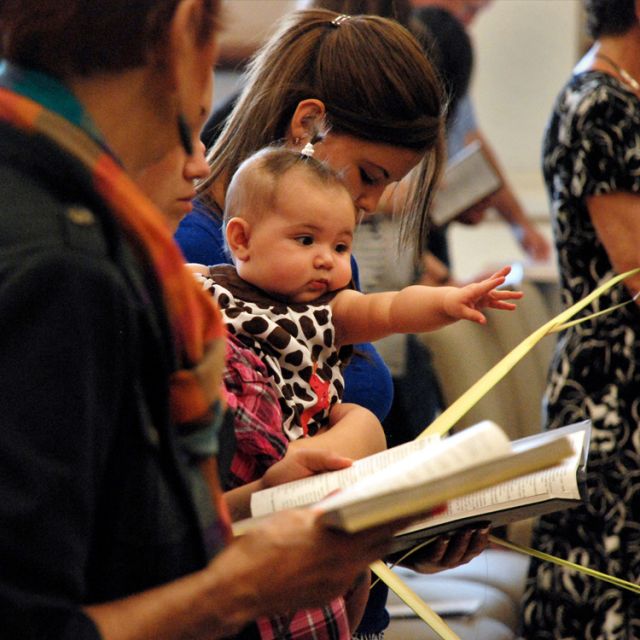I like the Seven Last Words best because the service is exceedingly simple and its leisurely pace allows ample space for solemn reflection. As a layman and in the seminary, I looked forward to all the special liturgical rites of Holy Week — each rich in meaning and all the more profound for only being done once a year. As parish priest, I hope my parishioners feel the same way, but without ranks of seminarians to attend to every part of the ceremony, I experience the liturgies of Holy Week more choreographically than spiritually! Just making sure that everything is done in the right order, by the right people, at the right time, preoccupies me. I am blessed with diligent altar boys, but my mind is usually “distracted” by making sure that I know what comes next. Even with rehearsals ahead of time, the primary focus for the priest is often on what is to be done, rather than what it means.
For that reason I am drawn to the simple, solemn and silent moments of Holy Week. There are two great silences on Good Friday. The first at the beginning of the liturgy, when the priest prostrates himself before the altar; the second during the reading of the Gospel, when the entire congregation kneels after St. John tells us that “He bowed His head and gave up His spirit.” I prefer to extend those moments until well after the congregation’s shuffling has ceased, and everyone, kneeling in silent contemplation, feels the weight of the mystery too great for words.
Holy Week is so rich in special symbols we can miss that the liturgy is slowly stripping itself bare. The washing of the feet, the veneration of the cross, the lighting of the candles, all this can distract us from the liturgy making itself ever more spare, ever more stark.
We begin the process on Ash Wednesday. We cease the Alleluia and suspend the Gloria. The flowers are gone from the sanctuary. The organ is reserved to accompaniment only — no voluntaries. As Holy Week draws near, statues and images are veiled. On Holy Thursday the organ falls silent entirely. The altar is literally stripped bare at the end of Mass. Most dramatically the Blessed Sacrament is removed from the tabernacle and taken to an altar of repose. The bare altar, the empty tabernacle, the extinguished sanctuary lamp — it is striking on Good Friday to enter a church that is achingly empty. Finally, the liturgy withholds two more things from us — sound and light. Good Friday begins and ends in silence. The Easter Vigil begins in darkness.
The great silences of Good Friday are profound moments for the priest. The prostration calls to mind his ordination and the bond between the great High Priest on the Cross and the priesthood He shares with those in Holy Orders. The kneeling during the reading of the Passion is also striking, for the priest is not accustomed to liturgical kneeling — at Mass, he never kneels, only genuflects.
The silence makes the deepest impression. At those moments all of the busyness, the preparation of the homilies, the choreography of the liturgy, the arranging of the church, the blessing of the palms and the preparation of the towels, the crucifix, the altar of repose, and the new fire — all can be laid aside when prostate before the altar or kneeling at it. There is nothing to be said, nothing to be done. It remains only to be silent before the news that silenced even the heavenly choirs of angels: God has died on the Cross.
There was much commotion at the foot of the cross — the weeping of the Blessed Mother, the taunting of the priests and scribes, the jeering of the soldiers — but on the cross, save for those seven painful occasions, Jesus is silent. Silent, for the pain of crucifixion makes it difficult to speak. And we remain silent, for the pain of seeing our Lord crucified — and for our sins! — stills our voice too.
Into the silence
By Fr. Raymond J. de SouzaHoly Week is not a particularly tranquil time for a priest.
In the midst of all the activity, I find Good Friday is the most resonant. My favourite service is actually extra-liturgical, the preaching of the Seven Last Words in our cathedral. It’s a two-hour service of readings, hymns and meditations, reflecting upon the seven times Jesus speaks from the cross. I have been preaching the Seven Last Words for nine years now, accompanied by the students at Newman House, who provide the music and do the readings.
Please support The Catholic Register
Unlike many media companies, The Catholic Register has never charged readers for access to the news and information on our website. We want to keep our award-winning journalism as widely available as possible. But we need your help.
For more than 125 years, The Register has been a trusted source of faith-based journalism. By making even a small donation you help ensure our future as an important voice in the Catholic Church. If you support the mission of Catholic journalism, please donate today. Thank you.
DONATE
